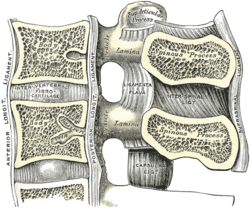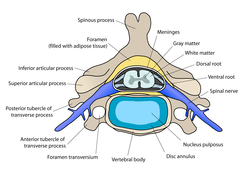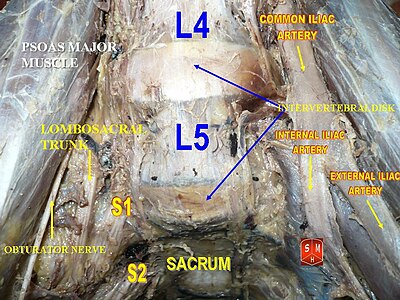Intervertebral disc
| Intervertebral disc | |
|---|---|
 Median sagittal section of two lumbar vertebræ and their ligaments (Intervertebral fibrocartilage labeled at center left). | |
 Costotransverse articulation seen from above (Intervertebral fibrocartilage labeled at top center). | |
| Details | |
| Identifiers | |
| Latin | Disci intervertebrales |
| MeSH | D007403 |
| TA98 | A03.2.02.003 |
| TA2 | 1684 |
| FMA | 10446 |
| Anatomical terminology | |
Intervertebral discs (or intervertebral fibrocartilage) lie between adjacent vertebrae in the spine. Each disc forms a cartilaginous joint to allow slight movement of the vertebrae, and acts as a ligament to hold the vertebrae together.
Structure
Discs consist of an outer annulus fibrosus, which surrounds the inner nucleus pulposus. The annulus fibrosus consists of several layers of fibrocartilage. The strong annular fibers contain the nucleus pulposus and distribute pressure evenly across the disc. The nucleus pulposus contains loose fibers suspended in a mucoprotein gel with the consistency of jelly. The nucleus of the disc acts as a shock absorber, absorbing the impact of the body's daily activities and keeping the two vertebrae separated. The disc can be likened to a jelly doughnut: whereby the annulus fibrosis is similar to the dough and the nucleus pulposis is the jelly. If one presses down on the front of the doughnut the jelly moves posteriorly or to the back. When one develops a prolapsed disc the jelly/nucleus pulposus is forced out of the doughnut/disc and may put pressure on the nerve located near the disc. This can give one the symptoms of sciatica.

There is one disc between each pair of vertebrae, except for the first cervical segment, the atlas. The atlas is a ring around the roughly cone-shaped extension of the axis (second cervical segment). The axis acts as a post around which the atlas can rotate, allowing the neck to swivel. There are 23 discs in the human spine: 6 in the neck (cervical region), 12 in the middle back (thoracic region), and 5 in the lower back (lumbar region). For example, the disc between the fifth and sixth cervical vertabrae is designated "C5-6".

Medical conditions related to the intervertebral disc
During development and at birth, vertebral discs have some vascular supply to the cartilage end plates and the annulus fibrosus. These quickly deteriorate leaving almost no direct blood supply in healthy adults.[1]
Before age 40 approximately 25% of people show evidence of disc degeneration at one or more levels. Beyond age 40, more than 60% of people show evidence of disc degeneration at one or more levels on a MRI.[2]
One effect of aging and disc degeneration is the nucleus pulposus begins to dehydrate and the concentration of proteoglycans in the matrix decreases, thus limiting the ability of the disc to absorb shock. This general shrinking of disc size is partially responsible for the common decrease in height as humans age. The annulus fibrosus also becomes weaker with age and has an increased risk of tearing. In addition, the cartilage end plates begin thinning, fissures begin to form, and there is sclerosis of the subchondral bone.[1] While this may not cause pain in some people, in others one or both of these may cause chronic pain. Other spinal disorders can affect the morphology of intervertebral discs. For example, patients with scoliosis commonly have calcium deposits (ectopic calcification) in the cartilage end plate and sometimes in the disc itself.[3] Herniate discs are also found to have a higher degree of cellular senescence than non-herniated discs.[1]
See also
- Back pain
- Sciatica
- Spinal disc herniation
- Vertebral column
- Lumbar spinal stenosis
- Disc decompression traction procedure
Additional images
-
Artificial intervertebral disc
-
Posterior longitudinal ligament, in the thoracic region.
-
Median sagittal section through the occipital bone and first three cervical vertebrae.
-
Costovertebral articulations. Anterior view.
-
Lumbar and sacral plexus. Deep dissection. Anterior view
-
Lumbar and sacral plexus. Deep dissection. Anterior view
References
- ^ a b c Roberts S, Evans H, Trivedi J, Menage J (2006). "Histology and pathology of the human intervertebral disc". J Bone Joint Surg Am. 88 (Suppl 2): 10–4. doi:10.2106/JBJS.F.00019. PMID 16595436.
{{cite journal}}: Unknown parameter|month=ignored (help)CS1 maint: multiple names: authors list (link) - ^ "Intervertebral Disc Disorders". MDGuidelines. Reed Group. 1 December 2012.
- ^ Giachelli CM (1999). "Ectopic calcification: gathering hard facts about soft tissue mineralization". Am. J. Pathol. 154 (3): 671–5. doi:10.1016/S0002-9440(10)65313-8. PMC 1866412. PMID 10079244.
{{cite journal}}: Unknown parameter|month=ignored (help)
External links
- Intervertebral Discs
- Spinal Disc Summary
- Cross section image: pembody/body12a—Plastination Laboratory at the Medical University of Vienna






